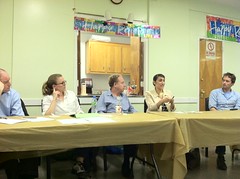New zoning meant to encourage retail diversity in the East Village might not go far enough, Community Board 3 considered last night. Speaking to the board’s Economic Development Subcommittee, an urban planner urged attendees to consider forming a group that would gather consumer data used to encourage landlords to let the butcher and baker move in — instead of the barkeep or “Sandwich Artist.”
The more aggressive — and costly — approach to retail diversity is also the most effective, said Larisa Ortiz, the head of Larisa Ortiz Associates, a consulting firm for commercial districts.
Only by collecting hard data that demonstrates that a fishmonger or cobbler (for example) can prosper in the neighborhood will landlords let them move in, Ms. Ortiz said.
“Most landlords prefer a tenant who they know month after month will pay the rent. The trick to this, when you’re looking for alternatives, is cultivating relationships with landlords, so they’re open to tenants who may not have the same credit,” she said, later adding, “It comes down to really understanding the motivation of property owners.”
Ideally a Business Improvement District, like the one in the Lower East Side, would tackle the extensive surveys required to properly assess locals’ shopping habits and needs. The problem, of course, is that a similar group — commonly known as a B.I.D. — doesn’t exist in the East Village.
“There’s nothing you can do until you have a few people or a B.I.D. that are much more formal.” Ms. Ortiz said. “Doing shop-local campaigns, helping them thrive and be successful is the best thing you can do to attract more businesses. Retailers like to co-locate.”
Ms. Ortiz suggested looking to the housing advocacy group Good Old Lower East Side for starters, and added that it is common for local economic development groups to evolve into B.I.D.s.
The improvement districts are often controversial, as they force property owners to pay dues to the B.I.D. in order to fund services like street-cleaning, trash collection and shopping promotions. Recently fights have raged over a B.I.D. in Chinatown and one proposed in SoHo.
“Let’s make connections with these landlords and get good information behind us and then say, ‘Look, this is what we have to offer,’” said subcommittee member Meghan Joye, explaining a scenario in which, with the right consumer demographic data and known demand, landlords may be willing to consider less-familiar tenants.
Previously, the board had considered creating Special Purpose Districts that would put a cap on chain stores and curb operating hours. But Ms. Ortiz said those districts aren’t the cure-all for an abundance of chain stores that some believe.
“It’s not well-honed. It’s not a scalpel,” said Ms. Ortiz.
But a new subcommittee member and real estate broker, Ben Landy, was skeptical that the additional outreach, backed by numbers and research, would keep landlords’ eyes off the bottom line, “I think it won’t work,” said Mr. Landy. “[Landlords] will go for the highest and best use and not reach out to local businesses.” Furthermore, even if a landlord can’t find a high bidder immediately, he explained, they’ll often wait instead of taking a chance on an unknown renter. “Getting a bad tenant in a space costs five times as much as keeping a space empty for a few months,” Mr. Landy added.
But with Ms. Ortiz’s formula for retail diversity presented before the subcommittee, other members, including another newcomer Jamie Rogers, co-owner of Pushcart Coffee, was more optimistic about the potential of the plan not only to attract more diverse businesses for customers, but also as a means to boost his own profits.
“It’s important for my business and other businesses around me to create more diverse retail,” said Mr. Rogers. “It seems like there’s a lot of gaps and we need to figure out how to connect some of these dots. I don’t have an answer to these questions, but I think that would be the best function for us, a method of connecting all these groups.”





